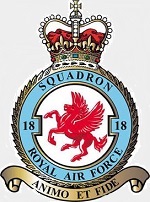Corgi AA38410 RAF Bristol Blenheim Mk. IVF Night Fighter - G-BPIV, Z5722 / WM-Z Spirit of "Britain First", Duxford Airfield, May 28th, 1993 (1:72 Scale)
"With courage and faith"
- Motto of No.18 Squadron
 Bristol Aeroplane's Blenheim was a British high-speed light bomber used extensively in the early days of the Second World War. It was later adapted into a successful heavy fighter. A Canadian-made variant named the Bolingbroke was used as an anti-Submarine and training aircraft. It was the first British aircraft to have all-metal stressed skin construction and one of the first to utilize retractable landing gear, flaps, powered gun turret and variable-pitch propellers.
Bristol Aeroplane's Blenheim was a British high-speed light bomber used extensively in the early days of the Second World War. It was later adapted into a successful heavy fighter. A Canadian-made variant named the Bolingbroke was used as an anti-Submarine and training aircraft. It was the first British aircraft to have all-metal stressed skin construction and one of the first to utilize retractable landing gear, flaps, powered gun turret and variable-pitch propellers.
In 1934 Lord Rothermere, owner of the Daily Mail, issued a challenge to the British aviation industry to build a high-speed aircraft capable of carrying six passengers and two crew members. At the time German firms were producing a variety of high-speed designs that were breaking records, and Rothermere wanted to recapture the title of fastest civilian aircraft in Europe. Bristol had been working on a suitable design as the Type 135 since July 1933, and further adapted it to produce the Type 142 to meet Rothermere's requirements.
When it first flew as Britain First at Filton on April 12th, 1935, it proved to be faster than any fighter in service with the Royal Air Force at the time. The Air Ministry was obviously interested in such an aircraft, and quickly sent out Specification B.28/35 for prototypes of a bomber version of the Bristol called the Type 142M (M for "military"). The main changes were to move the wing higher on the fuselage from its former low position, to allow room under the spar for a bomb bay. The aircraft was all-metal with twin Bristol Mercury VIII radial engines of 860 hp (640 kW) each. It carried a crew of three – pilot, navigator/bombardier and gunner/wireless operator and was armed with a forward firing 0.303 inch (7.7 mm) machine gun outboard of the port engine and a 0.303 inch machine gun in a semi-retracting dorsal turret firing to the rear. A 1,000-lb (454 kg) bombload was carried in the internal bay.
To achieve its relatively high speed, the Blenheim had a very small fuselage. Pilot's quarters on the left side of the nose were so cramped that the control yoke obscured all flight instruments while engine instruments eliminated the forward view on landings. Most secondary instruments were arranged along the left side of the cockpit with essential items like propeller pitch control actually placed behind the pilot where they had to be operated by feel alone. Like most contemporary British aircraft, the bomb bay doors were kept closed with bungee cords and opened under the weight of the released bombs. Because there was no way to predict how long it would take for the bombs to force the doors open, bombing accuracy was rather mediocre.
Pictured here is a 1:72 scale replica of a RAF Bristol Blenheim Mk. IVF night fighter that was restored on May 28th, 1993, at Duxford Airfield.
Sold Out!
Dimensions:
Wingspan: 9-1/4-inches
Length: 7-1/4-inches
Release Date: July 2021
 Historical Account: "We Own the Night" - With the restoration team behind the world's only airworthy Bristol Blenheim having to suffer the devastation of seeing their magnificent aircraft crashing at an Airshow in June 1987, only four weeks after making its first flight, you might think they would have struggled to find the resolve to start all over again. Thankfully, they were in no mood to accept defeat and almost immediately started a campaign to fund a second restoration, whilst at the same time scouring the world for the parts they would need. Using the wealth of experience they had gained during the initial restoration, this second project would be completed in around half the time and see a beautiful new Blenheim ready to make its first post restoration flight at Duxford in May 1993.
Historical Account: "We Own the Night" - With the restoration team behind the world's only airworthy Bristol Blenheim having to suffer the devastation of seeing their magnificent aircraft crashing at an Airshow in June 1987, only four weeks after making its first flight, you might think they would have struggled to find the resolve to start all over again. Thankfully, they were in no mood to accept defeat and almost immediately started a campaign to fund a second restoration, whilst at the same time scouring the world for the parts they would need. Using the wealth of experience they had gained during the initial restoration, this second project would be completed in around half the time and see a beautiful new Blenheim ready to make its first post restoration flight at Duxford in May 1993.
Looking very different to the first aircraft, Blenheim G-BPIV was built as an all-black Mk.IVF night fighter, with the serial Z5722 and wearing the codes WM-Z. This scheme was selected in honor of Wing Commander the Hon Max Aitken DSO, DFC, CZMC, as his personal aircraft during his time as the Commanding Officer of No.68 Squadron at RAF High Ercall during 1941. The aircraft also carried the name Spirit of 'Britain First' on its port side fuselage, in direct reference to the name carried by the first Blenheim ever to fly.


